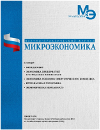Forecasting bankruptcies of counterparties based on payment discipline data
DOI: 10.33917/mic-4.93.2020.47-56
In this article, we study the problem of forecasting bankruptcy of firms using data on payment discipline. Most previous researchers used the balance sheet as a data source, while data on payment discipline will reduce the time before making a decision on the firm, as well as obtain reliability ratings based on other types of data. To predict bankruptcy of the firms proposed a new method of work with highly unbalanced data, which consists in training the classifiers on the automatically generated sub-sample and averaging the obtained results. Random forest served as a classifier for subsamples, and AUC-score was used to check the quality of the model, which showed good results.
References:
1. Andrjovská A., Bánociová A. Payment discipline in business environment// Procedia Economics and Finance. 2014. Vol. 15. pp. 1217-1224.
2. Bekkar M., Djemaa H. K., Alitouche T. A. Evaluation measures for models assessment over imbalanced data sets // J Inf Eng Appl. 2013. V 3. № 10.
3. 5, class imbalance, and cost sensitivity: why under-sampling beats over-sampling / C. Drummond, R. C. Holte [et al.] // Workshop on learning from imbalanced datasets II. Vol. 11. Citeseer. 2003. pp. 1-8.
4. Dimensionality reduction for fast similarity search in large time series databases / E. Keogh [и др.] // Knowledge and information Systems. 2001. Vol. 3. № 3. pp. 263-286.
5. Hu W. Overdue invoice forecasting and datamining/ Hu Weikun. Massachusetts Institute of Technology, 2016.
6. Kiang M.Y. A comparative assessment of classification methods //Decision Support Systems. 2003. Vol. 35. № 4. pp. 441-454.
7. Kotsiantis S. B., Zaharakis I., Pintelas P. Supervised machine learning: A review of classification techniques// Emerging artificial intelligence applications in computer engineering. 2007. Vol. 160. pp. 3-24.
8. Kumar P. R., Ravi V. Bankruptcy prediction in banks and firms via statistical and intelligent techniques -A review // European journal of operational research. 2007. Vol. 180. № 1. pp. 1-28.
9. Ohlson J.A. Financial ratios and the probabilistic prediction of bankruptcy //Journal of accounting research. 1980. pp. 109-131.
10. Predicting financial distress of companies: revisiting the Z-score and ZETA models/ E.I. Altman [et al.] // Stern School of Business, New York University, 2000.
11. Predictive modeling for collections of accounts receivable / S. Zeng [et al.] // Proceedings of the 2007 international workshop on Domain driven data mining. ACM. 2007. pp. 43-48.
12. Quinlan R. C5.0: An Informal Tutorial. 2017 [Electronic resource]. – Режим доступа: rulequest.com/see5-unix.html. (date of access: 01.11.2018).
13. Sokolova M., Lapalme G. A systematic analysis of performance measures for classification tasks // Information Processing & Management. 2009. Vol. 45. № 4. pp. 427-437.
14. Wagenmans F. Machine Learning in Bankruptcy Prediction: диссертация / Wagenmans Frank, 2017.
15. Zmijewski M.E. Methodological issues related to the estimation of financial distress prediction models // Journal of Accounting research. 1984. pp. 59-82.


